 |
 6th September 1998 |
Front Page| |
Simple evocation of the past"This civic building, of quite modern construction,
being designed with an eye to use rather than ornament, presents architectural
features worthy of note.'' Thus did an anonymous author in 1906 dismiss
what is today the most fascinating of Colombo's old public buildings: the
former Town Hall in Pettah. For a clue as to why the writer in the book, Twentieth Century Impressions of Ceylon, is so disparaging about this delightful building, we must look at what he says about Pettah: "Here in the heart of the native part of Colombo, is never lack of bustle and life, and, it may be added, never lack of smell.'' What was accurate 92 years ago still applies; there is a distinct aroma of toilet about the busy place. However, when the writer states that the Town Hall is ''unworthy from the architectural standpoint of the dignity of the metropolis of Ceylon,'' you realise he is a building snob, preferring the grand mansions of Cinnamon Gardens to Pettah's humbler properties. However, it must have been regarded as a bold venture when, in 1873, Colombo's Town Hall was constructed outside the Fort. It was farsighted of town planners to recognise Pettah's importance, despite it being regarded as the ''native quarter,'' while the Fort was the preserve of the European establishment. The original building had to be extended but at the beginning of this century it looked as it does to this day. That it still stands at all is remarkable, especially as it is almost overwhelmed by a thicket of trinket shops, throngs of pavement vendors, and the bazaar culture that clutters the streets surrounding it. Only two stories tall, it is lent authority by its slender spires that sprout from the frieze bordering the base of its peaked roof. Perhaps these were the British architect's riposte to the minarets and stupas of Colombo's skyline. The building served as the centre of municipality's government for 65 years. Finally, in 1928, the city fathers removed themselves to the more sedate environs of Cinnamon Gardens. The flotsam and jetsam of Pettah's street trading continued to lap at the portals of the building. Its premises served as a public market until, in 1979, bureaucracy reasserted itself. An inscribed brass plaque at the entrance reads: "This old Town Hall building of the Colombo Municipal Council, which faced neglect and decay, was renovated by the Council on the direction of R. Premadasa, Prime Minister of Sri Lanka, to preserving it for posterity, with its original grandeur restored and it having been re-established as a municipal museum and a cultural art and trade centre.'' In 1984 it was declared open to the public. Care continues to be taken to preserve not only the building but also the intriguing relics of the municipality that are exhibited in its open-sided forecourt. Among items on display is a gas lamp, one of 2,000 that lit Colombo's streets in 1872. Here, too, is to be found the famous landmark that once graced the seaside of Galle Face Green. It is the original stone on which is carved the inspired sentiment: "Galle Face Walk. Commenced by Sir Henry Ward, 1856, completed 1859, and Recommended to his Successors in the Interest of the Ladies and Children of Colombo''.
The tall, wooden entrance doors establish the Gothic Revival theme of the building. Each is topped with an elaborate fanlight of floridly carved latticework that is part of the door, and fits snugly into the sharply arched doorway. The pointed shape of the fanlight is copied in every exterior window, creating an almost ecclesiastical ambiance. Six-pointed stars etched into exterior walls are matched by the four-pointed ones of interior walls. The entrance leads to a gallery and offices, one of which still has odd pieces of furniture, like a cornered cloak stand and a polished lectern box. The ceilings are of boards whose deep mahogany hue suggests an atmosphere of comfortable conformity. Upstairs in the council chamber, effigies of the 16 participants at a 1906 council meeting, sit around a huge table. The models are so lifelike, visitors hesitate to intrude in case they might overhear their deliberations. That the effigies look so smart and real is due to regular maintenance costing several thousand rupees a year just for laundering their clothes. Doors from the council chamber open onto a balcony that embraces its three sides, above the portico. Windows of an ingenious design enclose the balcony. Each window drops down on its sash into a cavity below and can be replaced by raising a frame of wooden louvres. Opposite is the courtroom. The rooms and corridors of the entire building are hung with chandeliers, each with four corner and one central glass, belle epoque globe shades. The preservation of the old Town Hall as it used to be in its heyday gives a fascinating glimpse of the past. In its simple way it seems more evocative of a bygone age than those grand edifices of Cinnamon Gardens. |
||
 |
Front Page| News/Comment| Editorial/Opinion| Business| Sports | Mirror Magazine |
|
 |
Please send your comments and suggestions on this web site to |
|

 The
museum on one side and the cluster of boutiques on the other, do not detract
from the building's impressive, high-roofed, double portico. Horse-drawn
carriages and, later, motor vehicles, could be driven under it from both
sides, so dignitaries could alight protected from sun and rain.
The
museum on one side and the cluster of boutiques on the other, do not detract
from the building's impressive, high-roofed, double portico. Horse-drawn
carriages and, later, motor vehicles, could be driven under it from both
sides, so dignitaries could alight protected from sun and rain.